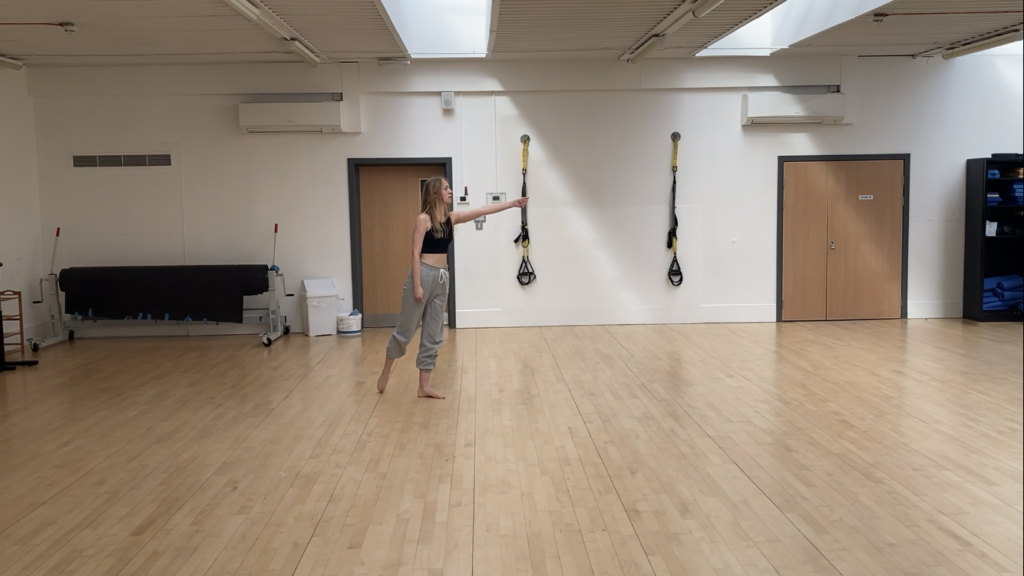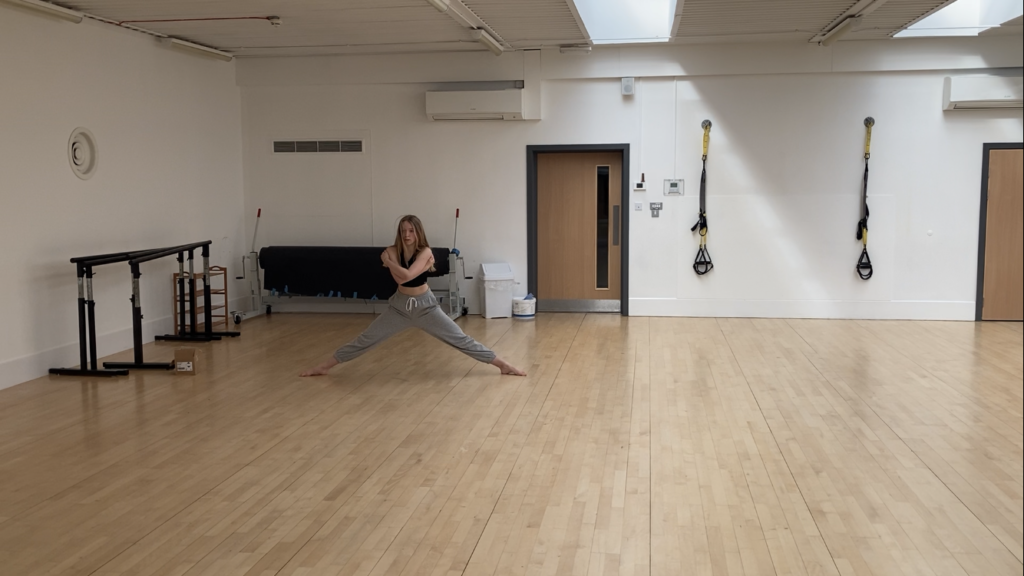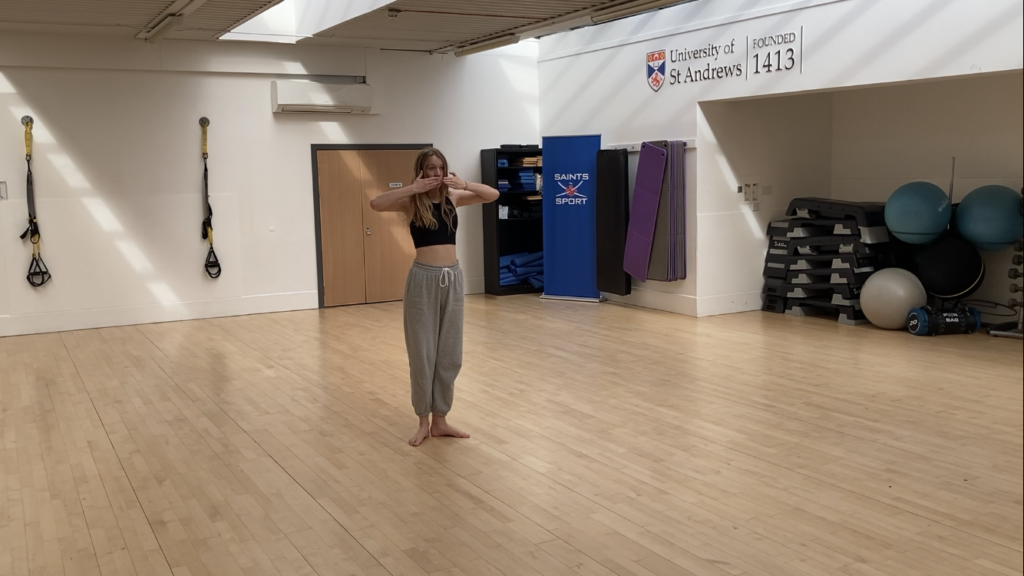'I have always turned to dance as a means of feeling at peace – when I am feeling inner-conflict, it becomes a vessel for me to express my emotions and release any tensions. I wanted to challenge myself to try and shift my dance movement from solely bringing myself peace to instead representing peace through movement. I wrote a short paragraph which posed some of the recurring questions we have discussed throughout our research into habits of visualising peace, and then I choreographed a contemporary piece in response to this written word.'
Spoken Words
What is peace?
Is peace a dove, soaring through a blue sky? A feather gently floating down.
Is peace the silence falling on a battlefield, as a sheet of paper is signed?
The smile of a child, a laugh released after hours of tears?
Or the white, floaty dress in a field of poppies on a summer’s day?
Does peace have a face? Can it see us through its eyes, speak to us through its mouth?
Is it a mother, a woman, men in a board room?
Can it be seen through all the pollution of conflict and war?
Is it an emotion, an experience, an idea?
Can it ever truly be achieved?
Or are we trapped in a cyclical world where peace remains a utopia, just out of reach?
The complexities of peace intertwine our worlds
Inner, community, global
Does it start from the ground,
A seed planted in a mind, sprouting, creating change?
Does it rain down from above?
From a child, to an adolescent, to an adult, to an elder,
Stories of peace are passed down,
Hope being held out that the next generation will implement change.
The inner battles one faces.
Can wider peace be attained if we do not feel personal peace?
Can peace be attained if we do not cooperate?
Can peace be attained if we do not all try and help others?
Let peace be attained.
How can dance represent and create peace?
I feel that this piece is more a set of questions posed than a clear representation of peace. in the words I wrote that inspired my choreography, I used stereotypical imagery of nature, doves, women, and peace as disarmament; then I juxtaposed this with the more challenging questions of whose peace we are talking about, whether peace can be defined as a noun, if it is a social construct more than an abstract idea, and how inner peace and grassroots peace-making contrast to global peace and top-down approaches. In the process of writing and choreographing, my own understanding of peace developed further.
When I first began this research project, I had very stereotypical views of peace. My interpretations came from mainstream British and Western media, and having come from a privileged position of never encountering major conflict I continued to hold onto this imagery, whilst feeling somewhat cynical about it because it appeared utopian and unachievable in our global society. This research project has really challenged my perception of peace, helping me realise that it is much more complicated than the hope embodied by a dove or the signing of an armistice. It has raised more questions for me than I thought was possible, but also shown me where to find hope for the future, as individual pockets of peace arise and empathy for others is nourished. Additionally, the importance of grassroots organisations and kinship or intergroup relations (as opposed to top-down peace-making initiatives) is something I have come to understand better: feeling empathy and drawing on diverse experiences can help build more sustainable peace, in contrast to paper-thin political peace agreements.

In regard to the movement, I used jumps such as leaps and glisés to symbolise hope for the future of peace, alongside the joy the idea of peace can bring. This was furthered by flowing movements at the beginning of the piece, such as a waltz step, chaine turns and flowing arms. Just as dance movements flow into each other, so ‘peace movements’ can catalsye each other, flow outwards and gain momentum. I chose these movements also to show how fluid a concept peace can be, something that can evolve and be developed. Their gentleness also embodies our common assumptions that peace itself is gentle.

I contrast these movements as the peace goes on, putting in sharper arm movements, and more awkward, contemporary positions to illustrate the awkward questions we must ask ourselves to move beyond comfortable stereotypes and gain a deeper understanding of what peace is and what peace-making involves. Peace is often dogged by recurring or barely suppressed conflict. I included a windmill turn, followed by a barrel jump into a lunge with an extended arm to bring conflict into the piece/peace, as these movements are quick and powerful, cutting through the air. The sharpness, and continuous turns also show confusion, spiralling out of control as conflict often does.

I juxtaposed this with moments of stillness and poses straight afterwards, to represent the pockets of peace that can arise even when conflict is ongoing. This reminds us that, while peace may not be all encompassing, it can still be present and found in the small moments, offering a chance to regroup and fuel the hope that wider peace can be achieved. I also used floorwork, such as backward rolls, rolls, crucifixes and pushing up in an arch to represent that work that is involved in peace-making, and particularly to highlight the idea of grassroots peace, being built from the bottom up, as opposed to imposed from the top down. I used different levels to show the generational differences in understanding peace, and how we often look forward to the next generation as the ones who will make a difference and achieve global peace. I ended the piece in the same position I began, standing with my head down, to show that peace is a cycle – it is not a constant solid state, but instead occurs in a cyclical motion within our society, as peace is gained and then lost, and so on.
Overall, I feel that this piece is highly emotive, and it invites reflection on the use of movement as a medium for representing peace, opening up space for communication and expression in a non-verbal way.[i] Dance has the potential to be a form of peace ‘artivism’, wherein art and activism are combined.[ii] As a bodily medium of communication, dance can get us thinking about what peace means to individuals and communities in very physical and tangible (as well as more metaphorical and philosophical) ways. Dance is an ’embodied’ form of storytelling, bringing peace to life through physical movements and expressing emotion in a non-confrontational manner. Even a solo dance can elicit a physical as well as emotional response, as viewers’ bodies instinctively respond to the movements they watch. Dance can be highly collaborative too. It therefore holds potential to be a tool of peace-building and not merely a way of representing peace.
What do you think?

- How inspiring do you find movement or dance as a medium for visualising peace?
- How would you represent peace in dance or movement?
- In what ways can you imagine dance being used as a tool for peace-building?
- Thinking about the words to which the dance is set, are there any questions here that prompt your thoughts, or that you disagree with? If so, why?
- Is feeling inner peace important for wider peace-building?
If you enjoyed this item…
You might also enjoy ‘Care through Music‘, ‘Make me a Channel of your Peace‘, ‘Peace from Pieces‘, ‘Visualising Peace after Forced Displacement‘ and other items with the tag ‘Embodied Peace‘.
A Bit About the Author:
I am twenty-one years old, and I have lived in Scotland my whole life, being born in Edinburgh and then moving as a student to the University of St Andrews. I am currently in my third year, studying Modern History and Social Anthropology. I have been dancing since I was two years old, and have recently started contemporary dance. I began working on the research project ‘Visualising Peace’ in January 2022, which I choreographed this dance for.
Claire Percival, May 2022
[i] These articles contain some interesting reflections on the connect between dance, cultivating empathy, ‘quieting one’s mind’, finding inner peace and building peace more widely: https://www.manchesterhive.com/view/9781526143402/9781526143402.00009.xml and https://scholarworks.umt.edu/umcur/2014/oralpres2e/6/. This book offers a more in-depth analysis of the relationship between peace-building and dance: https://www.manchesterhive.com/view/9781526143402/9781526143402.xml.
[ii] You can read more about ‘artivism’ here https://www.opendemocracy.net/en/5050/artivism-art-as-activism-activism-as-art/. This research project focuses on artivism as a way of combatting conflict: https://sites.manchester.ac.uk/the-art-of-peace/home/about/ and this NGO promotes creativity ‘in place of war’: https://www.inplaceofwar.net. You can hear more about both projects on this podcast: https://www.buzzsprout.com/1717787/9753664.